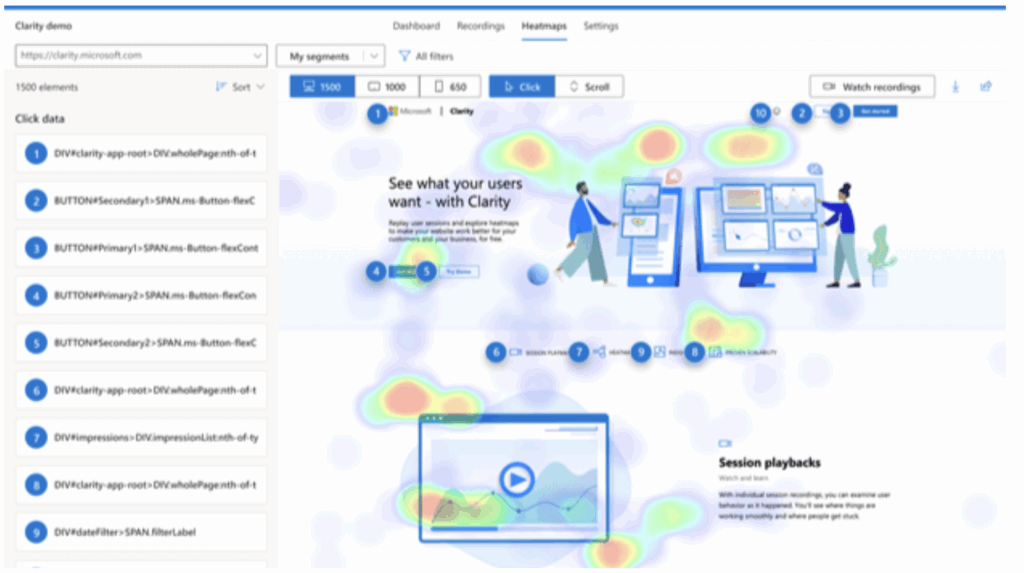
Microsoft Clarity excels at heatmaps, session recordings, and behavioral analytics—but it’s not alone in the space. Here are prominent alternatives.
Key Competitors Offering Similar Services:
Hotjar
Capabilities: Heatmaps (click/scroll/move), session recordings, feedback widgets/surveys, funnels & trends; simple setup. Advantages: Very easy to deploy and use; strong built-in feedback tools; unified filters across surveys/recordings/heatmaps. Disadvantages (from user reviews): Occasional sluggish loading of recordings; advanced product analytics limited vs. pro DXA tools. Link: hotjar.com
FullStory
Capabilities: High-fidelity session replay, autocaptured product analytics (metrics drill-downs link to replays), frustration/UX signals. Advantages: Seamless pivot between quant (dashboards) and qual (replays); rich DX analytics for adoption/retention issues. Disadvantages (from user reviews): Learning curve/UI not always intuitive for new users. Link: fullstory.com
Contentsquare
Capabilities: Enterprise DX analytics; AI-assisted insights; zone-based heatmaps with element-level metrics like conversion rate/revenue per click. Advantages: Ties behavior to business KPIs at element level; fast insighting for large catalogs/journeys. Disadvantages: Enterprise-oriented pricing/complexity Link: contentsquare.com
Mouseflow
Capabilities: Session replay, heatmaps, journey analytics, friction detection, forms analytics, feedback. Advantages: Broad toolset in one UI; good for mapping entire customer journey and spotting drop-offs. Disadvantages (from user reviews): Dashboard can feel busy; storage/filters sometimes limiting on high-traffic sites. Link: mouseflow.com
Smartlook
Capabilities: Session recordings, event tracking, funnels; generate heatmaps directly from recordings (no waiting), web & mobile. Advantages: Quick “from replay to heatmap” workflow; straightforward trials/demos. Disadvantages: Smaller ecosystem/brand reach than Hotjar/FullStory (market presence inference). Link: smartlook.com.
LogRocket
Capabilities: Session replay plus error tracking, network/console logs, product analytics, performance monitoring. Advantages: Engineering-friendly debugging context (console/network), privacy masking, AI summaries. Disadvantages (from user reviews): Pricing/session-based costs can be hard to predict; some users note initial UI complexity. Link: logrocket.com.
Lucky Orange
Capabilities: Session recordings, dynamic heatmaps, surveys, real-time insights; “Discovery” (guided CRO questions). Advantages: Quick to implement; lightweight; strong real-time views per G2 users. Disadvantages (from reviews/positioning): Fewer deep product-analytics features than enterprise DX suites. l Link: luckyorange.com
PostHog
Capabilities: Open-core product analytics, feature flags, A/B testing, session replay (web & mobile), dev-centric tooling. Advantages: All-in-one product analytics + experimentation in one stack; strong developer features. P Disadvantages: Requires more setup/governance vs. out-of-box UX tools (inference from developer-oriented model). Link: posthog.com.
Heap (now part of Contentsquare)
Capabilities: Autocapture of every click/tap/field, retroactive analysis, product analytics. Now integrated into Contentsquare platform. Advantages: No upfront tagging; retrospective questions on past data; speeds up analytics for product teams. Disadvantages: Autocapture can require governance to keep events meaningful; company/brand now folded into Contentsquare. Link: heap.io (redirects to Contentsquare announcement).
Glassbox
Capabilities: Enterprise session replay (web & mobile), journey analytics, issue impact measurement, CX/Support workflows; captures client + technical/server-side events. Advantages: Deep troubleshooting context and business impact tools; strong enterprise references. Disadvantages: Enterprise complexity/pricing; heavier deployment than lightweight tools (inference from positioning). Link: glassbox.com.
UXCam (mobile-first)
Capabilities: Mobile app session replay, heatmaps, event analytics, segments; SOC2/GDPR/CCPA notes; integrates with other analytics stacks. Advantages: Purpose-built for mobile teams; strong session replay & mobile signals. Disadvantages: Web analytics less of a focus; best when mobile is primary. Link: uxcam.com
2) Why Microsoft Clarity is compelling (beyond being free)
- Core feature depth for $0: Heatmaps and high-volume session recordings with ML-based “Insights” (rage clicks, dead clicks, excessive scrolling, quick backs). These pinpoint UX friction without extra tagging.
- Click-type heatmaps: Built-in visualizations for rage, dead, first/last, and error clicks accelerate diagnosis of confusing UI and JS issues.
- Searchable recordings & filters: Quickly isolate sessions by frustration signals/device/browser to watch only the moments that matter.
- Integrations that bridge marketing + UX: Native Google Analytics dashboard in Clarity; Google Ads integration GA (2025) to tie campaign performance to behavioral evidence in replays/heatmaps.
- Mobile app analytics: Official iOS and Android SDKs (plus React Native/Flutter, etc.) to capture app interactions, replays, and heatmaps—useful if your funnel spans web + app.
- Privacy posture: Microsoft publishes Clarity privacy guidance; masking tools and data policies help teams use session replay responsibly (important given industry scrutiny).
- Low friction to adopt: Lightweight install, generous data limits, and no sampling/paywalls—good for teams starting CRO/UX work or augmenting GA.
3. Real-World Use Cases & Success Stories
Microsoft Clarity has been adopted across industries to drive tangible results. Here are some compelling examples:
- ufurnish.com: Revised their pop-up timing to reduce frustration and improved filtering usability—enhancing both engagement and marketing ROI.
- Places for People: Increased page views dramatically—241% boost on a key page and 63% across another—by leveraging heatmaps and audit plans.
- Supademo: Simplified onboarding flows, resulting in 10% higher completion, a 20% boost in activation, and 39% faster time to value.
- Numerous other cases: From form submission gains to conversion lift, many organizations report between 10%–300% performance boosts across sign-ups, engagement, and CTAs.
What’s the one feature competitors nail that Clarity doesn’t?



